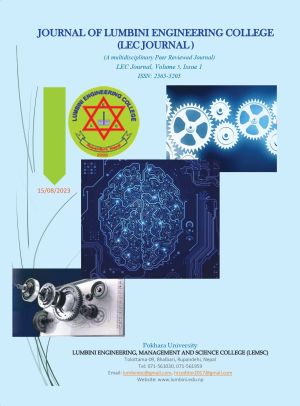Experimental and Theoretical Study on Electronic and Optical Properties of TiO2 (anatase) Bulk and Al Doped Thin Film Phases
DOI:
https://doi.org/10.3126/lecj.v5i1.60116Keywords:
TB-LMTO, Thin film, Spin coating, Bandgap, swanepoel methodAbstract
Tuning the electronic and optical properties of TiO2 is very important because of the variety of applications, including photocatalysts, electronics and data storage devices, and solar cells. Here, we performed the theoretical and experimental investigation of electronic, and optical properties of TiO2 and Al doped TiO2 in the form of bulk and thin film. A tight binding linear muffintin orbital (TB-LMTO) approach is used to optimized the TiO2 (anatase) in bulk phase. The optimized lattice parameter of TiO2 (anatase) is found to be 3.89Å.The band structure plot reveals that bulk TiO2 (anatase) bears wide bandgap semiconducting behavior with bandgap (Eg) 3.23 eV whereas thin film of aluminium doped TiO2 (anatase) behaves as a metal. The symmetric nature of up and down density of state (DOS) and projected density of states (PDOS) for both bulk and thin film of TiO2 (anatase) ensures their non-magnetic behavior. Experimental observation shows that the surface reflectance of the film increases with increasing concentration of aluminium (Al) while transmittance observed as opposite trends. The direct and indirect bandgaps of TiO2 film evaluated using transmittance curves are 3.53 eV and 3.27 eV respectively, which are well agreed with the available standard band-gap range of TiO2 film (3.2 eV to 3.65 eV). The direct band gaps for Al-1% and Al-3% doped TiO2 film are 3.60 eV and 3.62 eV respectively with thickness obtained from swanepoel method are 682.06 nm and 745.56 nm respectively.
Downloads
Downloads
Published
How to Cite
Issue
Section
License

This work is licensed under a Creative Commons Attribution-NonCommercial 4.0 International License.
This license allows reusers to distribute, remix, adapt, and build upon the material in any medium or format for non-commercial purposes only, and only so long as attribution is given to the creator.




